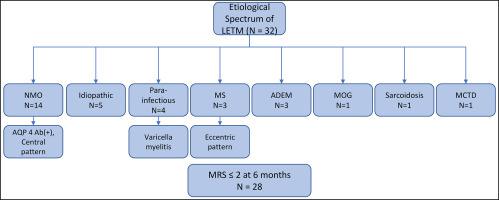当前位置:
X-MOL 学术
›
J. Neuroimmunol.
›
论文详情
Our official English website, www.x-mol.net, welcomes your feedback! (Note: you will need to create a separate account there.)
Etiological spectrum, clinico-radiological profile and treatment outcomes of longitudinally extensive transverse myelitis – A prospective study from Northwest India
Journal of Neuroimmunology ( IF 3.3 ) Pub Date : 2021-02-01 , DOI: 10.1016/j.jneuroim.2020.577456 Akanksha Choudhary , Amita Bhargava , Shubhakaran Khichar , Sangeeta Pradhan
Journal of Neuroimmunology ( IF 3.3 ) Pub Date : 2021-02-01 , DOI: 10.1016/j.jneuroim.2020.577456 Akanksha Choudhary , Amita Bhargava , Shubhakaran Khichar , Sangeeta Pradhan

|
OBJECTIVES
To study etiological, clinical and radiological profile and treatment outcomes in patients of longitudinally extensive transverse myelitis (LETM). METHODS
This was a prospective study conducted at Dr. S.N. medical college, Jodhpur, India, of patients presenting with LETM between March 2018 to March 2020. RESULTS
Our study included 32 patients (median age 32 years, female to male ratio of 2.5: 1). Neuromyelitis optica spectrum disorders (NMOsd) was the most common diagnosis affecting 14 patients followed by 5 patients of idiopathic myelitis, 4 patients of para-infectious myelitis, 3 patients of multiple sclerosis (MS), 3 patients of acute demyelinating encephalomyelitis (ADEM) and 1 patient each of myelin oligodendrocyte glycoprotein (MOG) antibody disease, sarcoidosis and mixed connective tissue disorder (MCTD). All the patients of NMOsd were positive for aquaporin 4 (AQP4) antibody. Spinal MRI showed central pattern of involvement in NMOsd and eccentric pattern of involvement in MS. All the patients of para-infectious myelitis were varicella myelitis. Twenty-eight (87.5%) patients had good clinical recovery at 6 months. CONCLUSION
Although, LETM is classically associated with NMOsd, it can have multiple etiologies. Identifying the etiology is important for long term treatment and prognosis which varies according to the disease. Patients in our study presented with relapses and severe disease but had good clinical recovery with treatment.
中文翻译:

纵向广泛性横贯性脊髓炎的病因谱、临床放射学特征和治疗结果——来自印度西北部的前瞻性研究
目的 研究纵向广泛性横贯性脊髓炎 (LETM) 患者的病因、临床和放射学特征以及治疗结果。方法 这是一项前瞻性研究,在印度焦特布尔 SN 医学院对 2018 年 3 月至 2020 年 3 月期间出现 LETM 的患者进行。结果 我们的研究包括 32 名患者(中位年龄 32 岁,男女比例为 2.5:1 )。视神经脊髓炎谱系疾病 (NMOsd) 是影响 14 名患者的最常见诊断,其次是 5 名特发性脊髓炎患者、4 名副感染性脊髓炎患者、3 名多发性硬化症 (MS) 患者、3 名急性脱髓鞘性脑脊髓炎 (ADEM) 患者和髓鞘少突胶质细胞糖蛋白 (MOG) 抗体疾病、结节病和混合性结缔组织病 (MCTD) 各 1 名患者。所有 NMOsd 患者的水通道蛋白 4(AQP4)抗体均呈阳性。脊柱 MRI 显示 NMOsd 的中心受累模式和 MS 的偏心受累模式。所有副感染性脊髓炎患者均为水痘脊髓炎。28 名 (87.5%) 患者在 6 个月时临床恢复良好。结论 尽管 LETM 通常与 NMOsd 相关,但它可能有多种病因。确定病因对于长期治疗和预后很重要,因疾病而异。我们研究中的患者出现复发和严重疾病,但经过治疗后临床恢复良好。28 名 (87.5%) 患者在 6 个月时临床恢复良好。结论 尽管 LETM 通常与 NMOsd 相关,但它可能有多种病因。确定病因对于长期治疗和预后很重要,因疾病而异。我们研究中的患者出现复发和严重疾病,但经过治疗后临床恢复良好。28 名 (87.5%) 患者在 6 个月时临床恢复良好。结论 尽管 LETM 通常与 NMOsd 相关,但它可能有多种病因。确定病因对于长期治疗和预后很重要,因疾病而异。我们研究中的患者出现复发和严重疾病,但经过治疗后临床恢复良好。
更新日期:2021-02-01
中文翻译:

纵向广泛性横贯性脊髓炎的病因谱、临床放射学特征和治疗结果——来自印度西北部的前瞻性研究
目的 研究纵向广泛性横贯性脊髓炎 (LETM) 患者的病因、临床和放射学特征以及治疗结果。方法 这是一项前瞻性研究,在印度焦特布尔 SN 医学院对 2018 年 3 月至 2020 年 3 月期间出现 LETM 的患者进行。结果 我们的研究包括 32 名患者(中位年龄 32 岁,男女比例为 2.5:1 )。视神经脊髓炎谱系疾病 (NMOsd) 是影响 14 名患者的最常见诊断,其次是 5 名特发性脊髓炎患者、4 名副感染性脊髓炎患者、3 名多发性硬化症 (MS) 患者、3 名急性脱髓鞘性脑脊髓炎 (ADEM) 患者和髓鞘少突胶质细胞糖蛋白 (MOG) 抗体疾病、结节病和混合性结缔组织病 (MCTD) 各 1 名患者。所有 NMOsd 患者的水通道蛋白 4(AQP4)抗体均呈阳性。脊柱 MRI 显示 NMOsd 的中心受累模式和 MS 的偏心受累模式。所有副感染性脊髓炎患者均为水痘脊髓炎。28 名 (87.5%) 患者在 6 个月时临床恢复良好。结论 尽管 LETM 通常与 NMOsd 相关,但它可能有多种病因。确定病因对于长期治疗和预后很重要,因疾病而异。我们研究中的患者出现复发和严重疾病,但经过治疗后临床恢复良好。28 名 (87.5%) 患者在 6 个月时临床恢复良好。结论 尽管 LETM 通常与 NMOsd 相关,但它可能有多种病因。确定病因对于长期治疗和预后很重要,因疾病而异。我们研究中的患者出现复发和严重疾病,但经过治疗后临床恢复良好。28 名 (87.5%) 患者在 6 个月时临床恢复良好。结论 尽管 LETM 通常与 NMOsd 相关,但它可能有多种病因。确定病因对于长期治疗和预后很重要,因疾病而异。我们研究中的患者出现复发和严重疾病,但经过治疗后临床恢复良好。


























 京公网安备 11010802027423号
京公网安备 11010802027423号